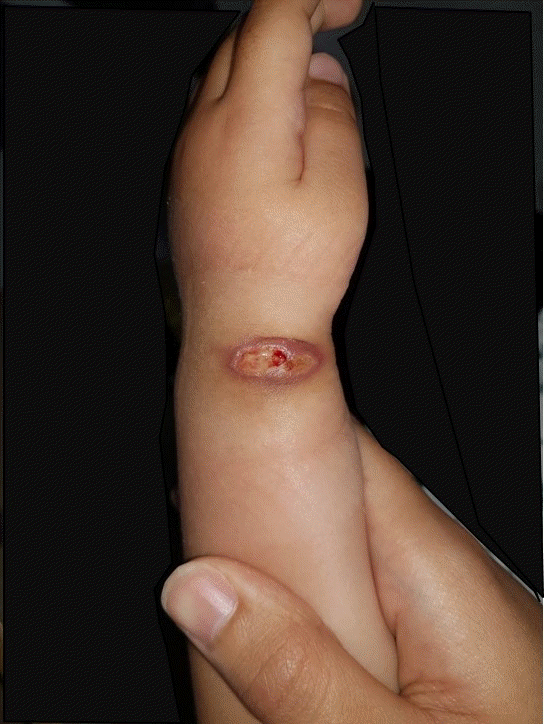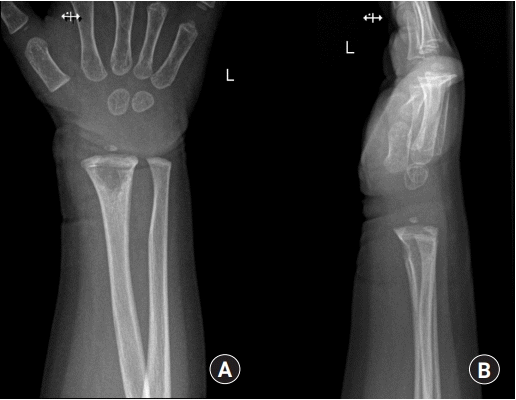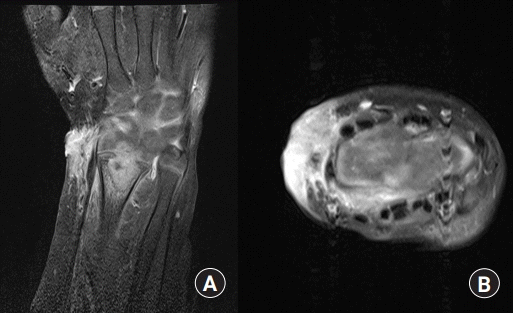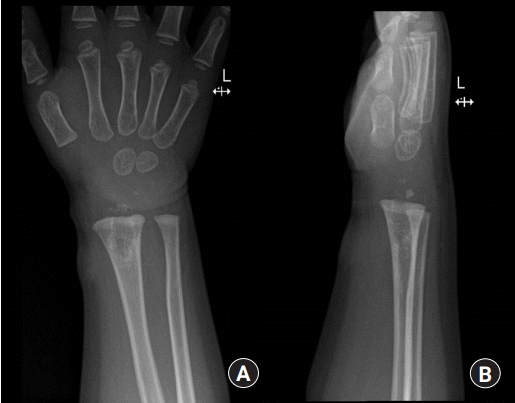This article has been
cited by other articles in ScienceCentral.
Abstract
BCG (Bacille Calmette-Guérin) vaccine has been administered safely to billions of people all over the world. The Tokyo-172 strain has reported to have a lower virulence and side effects than other strains. BCG osteomyelitis of distal radius is a very rare but serious complication due to generalized dissemination of BCG. We report a rare case of BCG osteomyelitis of the distal radius in a 21-month-old girl who had no underlying disorders. Although uncommon, BCG osteomyelitis should be considered a possible complication of BCG vaccination under certain clinical features for early diagnosis and proper treatment.
Go to :

Keywords: BCG vaccine, Osteomyelitis, Toddler
INTRODUCTION
In Korea, 95%−99% of children are vaccinated with BCG within 4 weeks after birth as a national policy for the management of tuberculosis. BCG was developed as a live attenuated vaccine from the serial passage of
Mycobacterium bovis [
1]. Currently, three types of BCG strains (Moscow-368, Sofia SL222, and the Tokyo-172) are commonly used worldwide [
2]. In Korea, the Pasteur 1173 P2, which had been used for more than 40 years, has been replaced by the Danish strain since 2007, and the Tokyo-172 was first introduced in Korea in 1993 and has been used steadily [
3]. World Health Organization (WHO) recommends the intradermal methods with the merits of being able to administer accurate doses at a certain level. South Korea also recommends the intradermal method. Although the Korean national immunization program for BCG vaccination is based on the intradermal Danish strain, the percutaneous Tokyo-172 BCG vaccine is also used. The proportion of percutaneous Tokyo-172 BCG vaccination is estimated to be more than twice that of intradermal Danish BCG vaccination during the recent 10 years [
4].
Among other BCG vaccines, Tokyo-172 strain has been reported to have a lower virulence and side effects than other strains. But as a live bacterial vaccine, BCG causes dissemination beyond the vaccination site to various parts of the body. Osteomyelitis is a very rare but serious late complication of BCG-immunization in immunocompetent individuals from generalized dissemination of BCG. Tokyo-172 strain is no exception. Here, we describe a rare case of BCG osteomyelitis of the distal radius in a 21-month-old girl who had no underlying immunodeficiency disorders.
Go to :

CASE REPORT
A 21-month-old girl who was healthy and never had undergone any disease presented symptoms of pseudoparalysis and tenderness with redness at her left wrist for a period of 1 month. There was no history of trauma, fever, or constitutional symptoms. According to the record of the Korea Centers for Disease Control and Prevention, she was vaccinated with Tokyo-172 BCG on the left upper arm at one month of age administered percutaneously using multipuncture method. At that time, as the doctor of the local clinic had an initial diagnosis of a ruptured inclusion cyst, the wound was dressed into an arm splint. Although, 2 weeks of oral cefpodoxime (third-generation cephalosporin antibiotics) therapy was maintained with a simple dressing, her wound was exacerbated and seemed to be cellulitis on her wrist (
Fig. 1).
 | Fig. 1.Preoperative photograph on radial aspect of the left wrist. About 2 x 1 cm sized ulcerative lesion involving subcutaneous layer. 
|
On admission, she had a normal body temperature of 36.6°C. Blood workup was carried out and showed normal parameters except mild elevation of erythrocyte sedimentation rate (29 mm/hr). A radiologic inspection was carried out and showed a distal pathologic geographic osteolytic lesion (
Fig. 2). Magnetic resonance imaging (MRI) showed subacute osteomyelitis within the left distal radius and growth plate involvement with cortical disruption. Also, an overlying infectious soft tissue enhancement with microabscess was noted (
Fig. 3). These features suggested a low-virulent bacterial infection or mycobacterial infection.
 | Fig. 2.The wrist X-ray image taken at the time of suspicion of osteomyelitis shows a well-defined metaphyseal lytic lesion with geographic pattern. (A) Left image, anteroposterior view, (B) right image, lateral view. 
|
 | Fig. 3.The wrist magnetic resonance image showing an aggressive lesion of the left distal radius combined with growth plate involvement and cortical disruption. (A) Left image, coronal view, (B) right image, axial view. 
|
Pus pocket was ruptured at dorsoradial aspect of the left wrist and debridement of the infected tissue was done through the opened pus pocket. After volar incision was made on the left wrist, a small hole was made at the radius volar side. Caseous material was curettaged and aspirated through the hole. A central physeal invasion was identified. All cultures including
M. tuberculosis were negative but the Xpert MTB/RIF assay (Cepheid Inc., Sunnyvale, CA, USA; molecular identification of
M. tuberculosis complex [MTBC] and resistance to rifampin [RIF]) identified
M. tuberculosis with negative rifampin resistance. We simultaneously performed a BCG specific polymerase chain reaction (BCG specific PCR) with the specimen obtained from an operating room for differential diagnosis of
M. bovis-BCG or others. According to the result of Xpert MTB/RIF assay, diagnosis of osteomyelitis of
M. tuberculosis was made, and we started the treatment with a regimen of rifampin, isoniazid, and pyrazinamide. After 2 weeks later, multiplex PCR for BCG Tokyo-172 strain was positive following the BCG specific PCR report. The detection of BCG substrains using the multiplex PCR allowed us to differentiate BCG osteomyelitis from other mycobacterial infections. After the result, the standard 12 months of anti-TB pharmacotherapy except pyrazinamide was planned because
M. bovis-BCG strain showed resistance to pyrazinamide. A 4-month follow-up X-ray showed a decreased extent of the osteolytic lesion and physeal growth (
Fig. 4). At 8 months follow-up visits, she showed gradual improvement and the pus no longer came out. She used her left forearm normally with a full range of movement.
 | Fig. 4.Four-month follow-up wrist X-ray with disappearance of the lytic lesion. (A) Left image, anteroposterior view, (B) right image, lateral view. 
|
Go to :

DISCUSSION
The BCG vaccine is used to protect recipients against severe forms of tuberculosis like disseminated tuberculosis and extrapulmonary tuberculosis. Serious adverse effects following BCG vaccination are rare. The most common adverse effects of BCG vaccination are local abscess. Osteitis or osteomyelitis is one of the rare consequences of BCG vaccination [
5]. (Osteitis and osteomyelitis mean the infects of the bone and bone marrow, respectively. However, medical literature usually does not clarify the distinction between osteitis and osteomyelitis [
6]. Both conditions are referred to here as osteomyelitis.) The incidence of BCG osteomyelitis following the BCG vaccine in Korea would be at least 4.08 cases per million during 2007–2017 [
2]. Previously, the incidence of osteomyelitis following BCG Tokyo-172 vaccination was reported to be extremely low. The incidence of BCG osteomyelitis in Japan where Tokyo-172 strain is administered by percutaneous multiple puncture method was 0.01 per million in the 1980s, the lowest compared to other countries [
7]. In Seoul National University Children's Hospital from January 2007 to March 2018, only 21 patients were diagnosed with BCG osteomyelitis [
2].
With its rarity, its onset is slow and the symptoms are usually mild. These points make it difficult to diagnose BCG osteomyelitis until it has well advanced. The most common symptoms of BCG osteomyelitis are mild pain and swelling of the overlying soft tissue, pseudoparalysis at the affected site, while fever was only accompanied in few [
8]. The diagnosis is also easily confused with bacterial osteomyelitis because of clinical findings and isolated, well-bounded osteolytic lesions in radiographs. It is important to recognize the distinctive features of BCG osteomyelitis from bacterial osteomyelitis. Children with bacterial osteomyelitis commonly show high fever and bone pain of abrupt onset. Only a few BCG osteomyelitis accompany fever and bacterial osteomyelitis can develop at any age in children while BCG osteitis usually develops between 6 months and 5 years of age [
9,
10]. There is a long latent period between the BCG vaccination and the onset of symptoms of osteomyelitis because the incubation period of BCG osteomyelitis ranges from six to nine months after the vaccination, and in most cases, the metaphysis and epiphysis of long bones are affected. According to a retrospective analysis of 222 cases, osteomyelitis was found in the femur (27%), tibia (19%), humerus (8%), and the sternum (15%) [
10]. In our center, osteomyelitis at the distal radius is the first case reported in toddler years (2−6 years old age). This also differs from disease caused by
M. tuberculosis, which more commonly occurs in the spine and weight-bearing joints in older children and adults.
Since it is difficult to distinguish BCG strains from other
M. tuberculosis complexes by conventional culture or biochemical analysis, many previous reports of BCG osteomyelitis have been clinically demonstrated without the characterization of strains by laboratory methods (
Table 1). In the absence of bacterial evidence, the inclusion criteria for BCG osteomyelitis are typical histopathological findings, such as a type of epithelial cell granuloma with caseous necrosis, or typical radiological findings, such as a well-defined and eccentrically located destruction in the metaphysis of a long bone, the history of BCG vaccination during the first year of life, and no evidence of pulmonary tuberculosis or a tuberculosis contact history [
10].
Table 1.
Diagnostic methods of BCG osteomyelitis and identification of BCG strain
|
Study |
Country |
No. of patient |
Key diagnostic method |
BCG strain (no. of patient) |
|
Erikson et al. [5] 1971 |
Sweden |
5 |
Clinical feature |
In 1 case, BCG laboratory result showed agreement between the patient's strain and the BCG strain used (but, no details). |
|
Radiologic finding |
|
Pathologic finding |
|
AFB stain/culture |
|
Peltola et al. [8] 1984 |
Finland |
10 |
Clinical feature |
Unknown |
|
Radiologic finding |
|
Pathologic finding |
|
AFB stain/culture |
|
Kröger et al. [10] 1995 |
USA |
222 |
Clinical feature |
Unknown |
|
Radiologic finding |
|
Pathologic finding |
|
AFB stain/culture |
|
Kim et al. [3] 2008 |
Korea |
2 |
Clinical feature |
Tokyo (2) |
|
TST |
|
Radiologic finding |
|
MTB PCR |
|
BCG specific PCR |
|
Choi et al. [2] 2018 |
Korea |
21 |
Clinical feature |
Tokyo (20) |
|
Radiologic finding |
Danish (1) |
|
Pathologic finding |
|
|
AFB stain/culture |
|
|
MTB PCR |
|
|
BCG specific PCR |
|

Genetically diagnosed cases of BCG osteomyelitis were reported from Japan in 1997 and from Taiwan in 2004, but only two cases were distinguished from M. tuberculosis osteomyelitis, and it was not known whether the cause was due to M. bovis or a specific BCG substrain. In Korea, since the late 2000s, there have been efforts to discriminate accurate BCG substrains using multiplex PCR technology, and the multiplex PCR method has been utilized and proved to be a rapid and reliable method. BCG osteomyelitis is a rare complication, so many clinicians are unfamiliar with this diagnostic method. Compared to the previous reports that focused on infection and technical aspects, we have described the process of diagnosing BCG osteomyelitis with the molecular methods from the surgeon's point of view.
Most BCG osteomyelitis shows a favorable prognosis. It is known to have a good prognosis usually with surgical debridement and oral antituberculosis chemotherapy, and this is also the difference from
M. tuberculosis infection [
5]. In this case, after the anti-TB pharmacotherapy she was able to move his left wrist with a normal range of motion and activity, and the wound was recovered without additional surgical intervention.
Osteomyelitis induced by BCG vaccination is uncommon but should be considered a possible complication. Clinicians should consider BCG osteomyelitis based on clinical features when the BCG vaccinated child under 5 years old show osteomyelitis, and select an appropriate diagnostic method for early diagnosis of BCG osteomyelitis and proper treatment.
Go to :





 PDF
PDF Citation
Citation Print
Print







 XML Download
XML Download